By Arthur Velwest, Writer, Game Master, and Custard enthusiast.
You can find and book games with us at https://booking.mastermindadventures.com
The Wild Beyond the Witchlight, Wizards of the Coast’s newest published module, has been getting a lot of buzz about its well-crafted story and refreshing approach to game design. One of Witchlight’s biggest draws is its starting carnival of the same name. Filled with wonderful attractions and lots to see and do, Game Masters everywhere are wondering: Where should my players go to have the best experience possible? Well, with the caveat that you know your players best and should craft a game best suited to them, here is my list of the five attractions you must see, four you can skip, and two honorable mentions. With fey-like abandon and spoilers ahead, let’s get started, shall we?
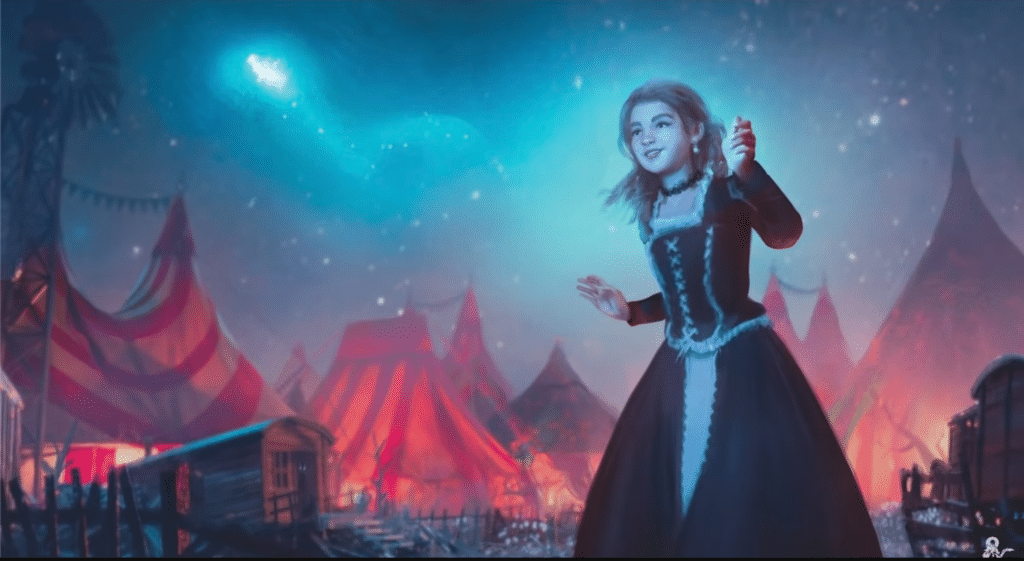
Must see:
The Calliope
Working the Calliope is a monkey with a tragic backstory and a love for buttons, and this is actually the attraction that inspired this article. The source of the carnival’s whimsical soundtrack, the calliope is a place easily skipped by many players, which is a shame because it’s a great example of my favorite part of this module, the foreshadowing. If your players give away one of their buttons for the reward of nothing more than a smile, they are actually rewarded with a single-use get-out-of-jail-free card. This is a great time to show their actions have consequences, and that kindness is always a great choice to make. And,if your players ever find themselves in a situation they can’t easily get out of, you have a ready-made emergency button that’s already in the narrative and makes your players still feel like they are the ones getting themselves out of the situation.
The Hall of Illusions
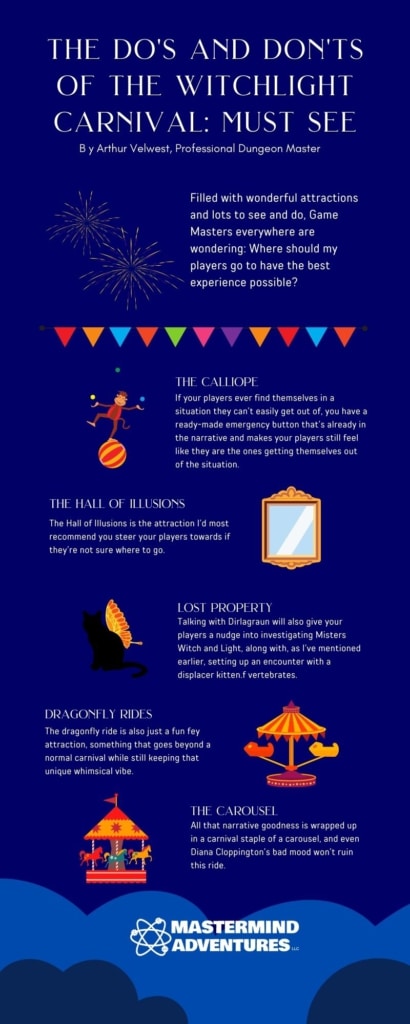
Wild Beyond the Witchlight must see
The Hall of Illusions is the attraction I’d most recommend you steer your players towards if they’re not sure where to go. Not only does it foreshadow the twist at the end of the module with the statue of Tasha/Iggwilv outside, reveal more about the world of Prismeer through its introduction of Sowpig the ghoulish thief, introduce an NPC who helps your characters meet Kettlesteam the kenku warlock, and help them perform all the way in chapter 4, but the hall itself is a great time to take a step back, relax and have your players reflect on their characters. What did their characters look like when they were young, what might they look like as they get older. An excellent character building exercise that should not be missed!
Lost Property
Lost property makes it on this list solely because displacer kittens are cute. I want them in my game, I want them in your game, I want them everywhere. Dirlagraun is a great warning of what the PCs could become if they don’t regain their lost items, as well as an interesting NPC that isn’t your standard elf, gnome, human, dwarf, etc. Talking with Dirlagraun will also give your players a nudge into investigating Misters Witch and Light, along with, as I’ve mentioned earlier, setting up an encounter with a displacer kitten. Which, as a GM, is its own reward.
Dragonfly Rides
While not affecting the game beyond the carnival (unlike some of the other attractions on this list), the dragonfly ride still stands as a great attraction and the best way to first introduce Kettlesteam the kenku warlock as an antagonist, as well as demonstrating that the mood of the carnival depends on your players’ rescue of the hapless blue-bearded dwarf trapped on a panicking dragonfly. The dragonfly ride is also just a fun fey attraction, something that goes beyond a normal carnival while still keeping that unique whimsical vibe. These are attractions after all, and this one sours high onto this list all on its own.
The Carousel
If I’m honest, I was a little worried at first that the carousel’s word puzzle would be too hard to figure out, leaving this attraction to be mostly a waste of time. However, the groups I’ve run figured out each unicorn’s name after some lovely back and forth, with each player contributing a little to the final result. I also feared when first reading the module that the unicorns would give too much away: all the hags names, locations, and weaknesses. That’s a bit much. But there is still more to the mystery that they have yet to discover, and having the hags names helps them have a direction to go in. Searching for more information about these hags is a great drive for your players. Setting up the worry and dread at the mention of the hags’ names makes your players fear them even before the first encounter. All that narrative goodness is wrapped up in a carnival staple of a carousel, and even Diana Cloppington’s bad mood won’t ruin this ride.
You Can Skip:
The Mystery Mine
As much as I love roller coasters, I don’t understand the thought process behind this one. A chance to think about your character’s biggest fear is a good idea, but causing nightmares for days after and possibly inflicting exhaustion levels is not. This feels like an overly harsh punishment. Places to have a long rest are fairly rare in the feywild so adding this onto some characters feels like a burden. A neat idea, poorly executed.
The Big Top
The big top is a wonderful environment, and another classic carnival staple, but as you will be visiting here during two out of three of the carnivals timed events, coming here a third time just for the characters to see a show, and maybe sneak backstage seems pointless. I suggest mentioning the backstage area when the characters are here during a timed event, but the rest of the big top can be left for the moments the clock calls for.
The Bubble-Pop Teapot
None of these events (except for maybe the mystery mine) are ones I’d specifically avoid. If going up in giant bubbles is all your players want to do, or you personally are excited to play a goblin who rhymes incorrectly, then by all means visit the Bubble-Pop Teapot! Otherwise, give this one a pass. Its high-flying experience is eclipsed by the Dragonfly Ride, and this module isn’t short on memorable characters to meet.
Snail Racing
Snail racing was originally an event I was very excited for; super fast giant snails are a funny image, and racing is a great way for players to compete against each other with non-deadly consequences. However, the reality of this game is just a lot of Animal Handling skill checks over and over, again and again. The “snail race surprises” table is sorely lacking in exciting twists, and the no-cheating warning at the start means none of your players’ cool abilities will be of use during the race itself. Snail racing is a really great concept that failed in execution. If you’re going to run it, I recommend making the entire thing shorter, allowing your players to use their abilities and magic, and taking the time to add a bunch of new things for the snail race surprises table.
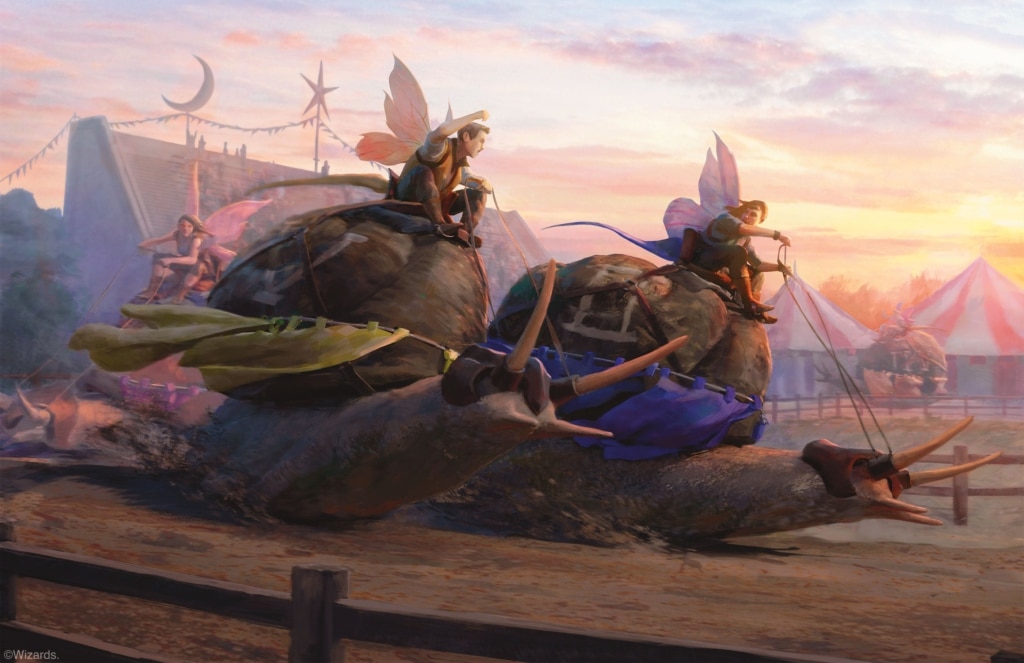
Honorable Mentions:
Silversong Lake
This event is extremely hit or miss depending on where your players are in the carnival’s story. Silversong Lake is another great Kettlesteam opportunity and an easy way to introduce Candlefoot the mime and his tragic backstory, as well as a great way to show the push and pull of the carnival’s changing mood. But, if your players already met Candlefoot and confronted Kettlesteam, this event is little more than a fancy show. Keep in mind which NPCsthey’ve already met when deciding if this event is worth steering your players towards.
The Feasting Orchard
Does the Feasting Orchard’s faerie cake eating contest have the same problems as the Snail Race? Yes, rolling a bunch of Constitution saves over and over can get quite boring. Why is it not on the skip list, you ask? Well, custard damage is funny and exactly the thing to put your players in the right mood for this module. An invisibility cupcake as a reward also keeps it off that list. Make this event chaotic and fast paced and roll on the wild magic surge table or something similar everytime they eat a cupcake. Go nuts! This is your game after all.
In Conclusion
In the end, your players are going to go to the events they’re interested in and it’s up to you to make each one as interesting and informative as you can. They haven’t read the book, so they won’t know what you changed. Take your players on an exciting adventure wherever they decide to go.
Except for the Mystery Mine of course. Avoid that one.
Arthur Velwest is a writer and Game Master for Mastermind Adventures. He fell in love with collaborative storytelling by LARPing at the ripe old age of 8. Using his exhaustive background in stage improv, long nights learning new game systems, and overactive imagination, Arthur brings his games to life. Arthur’s games explore themes of found family, prevailing after loss, mischief. You can find his games here.
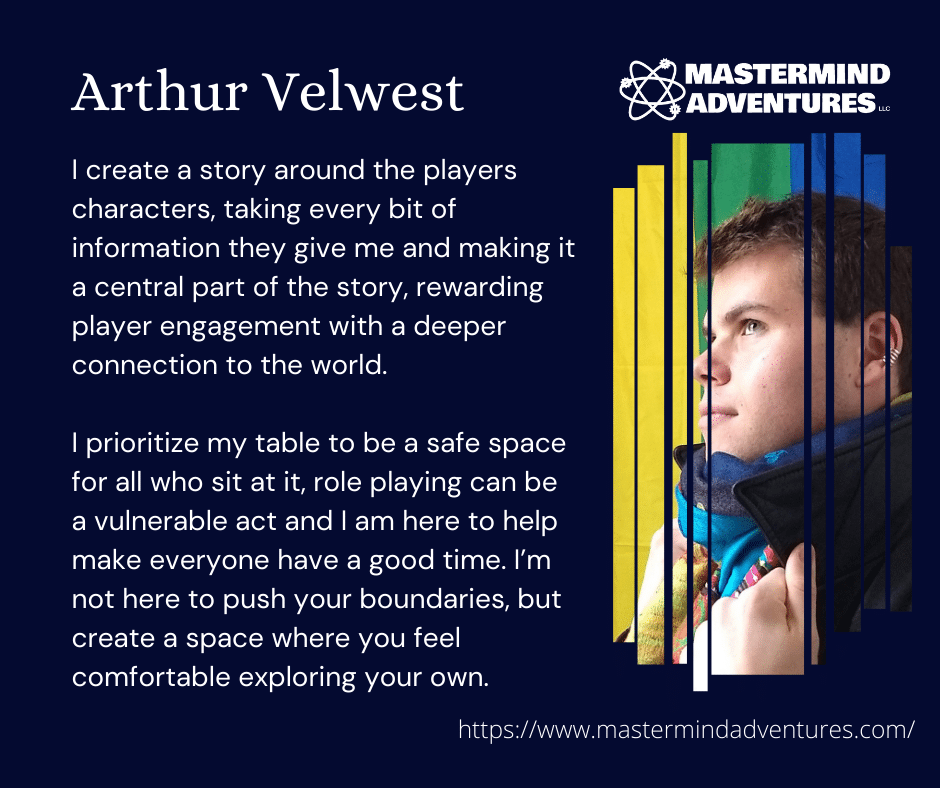


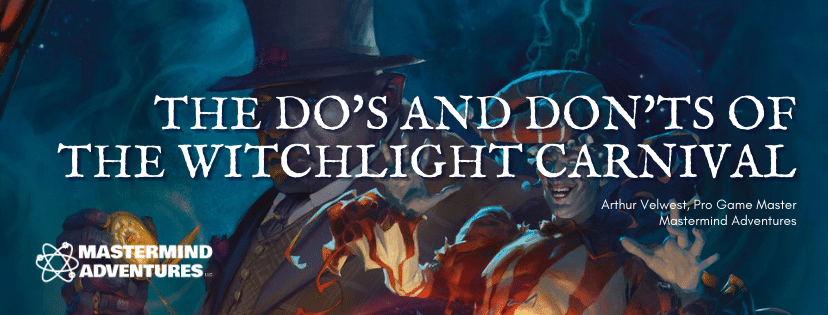

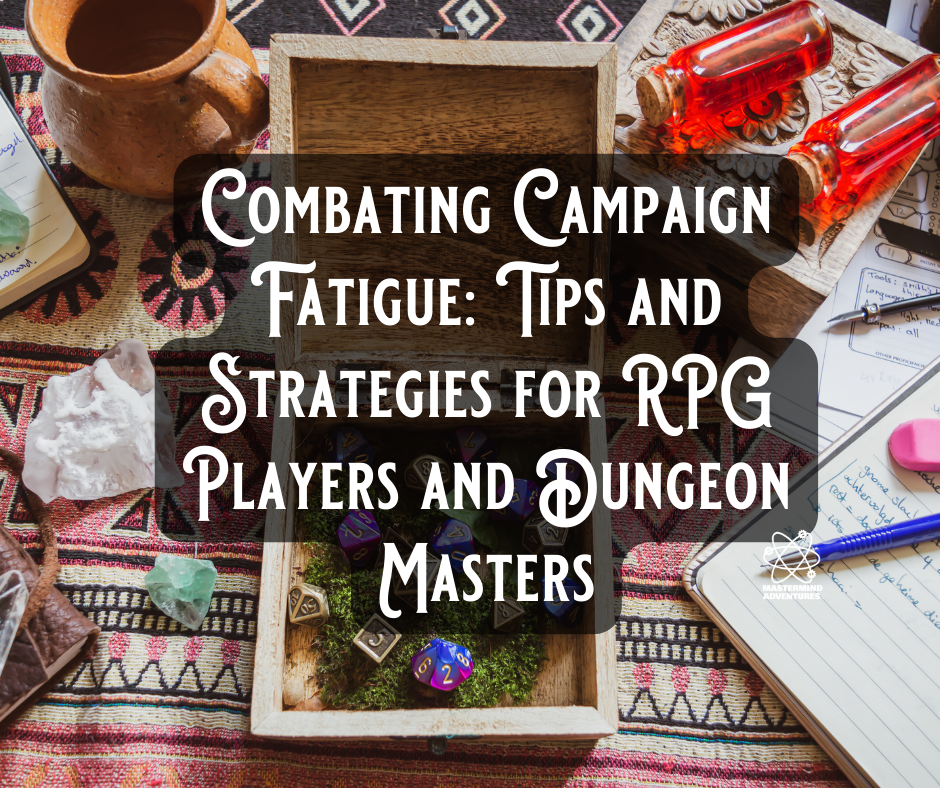


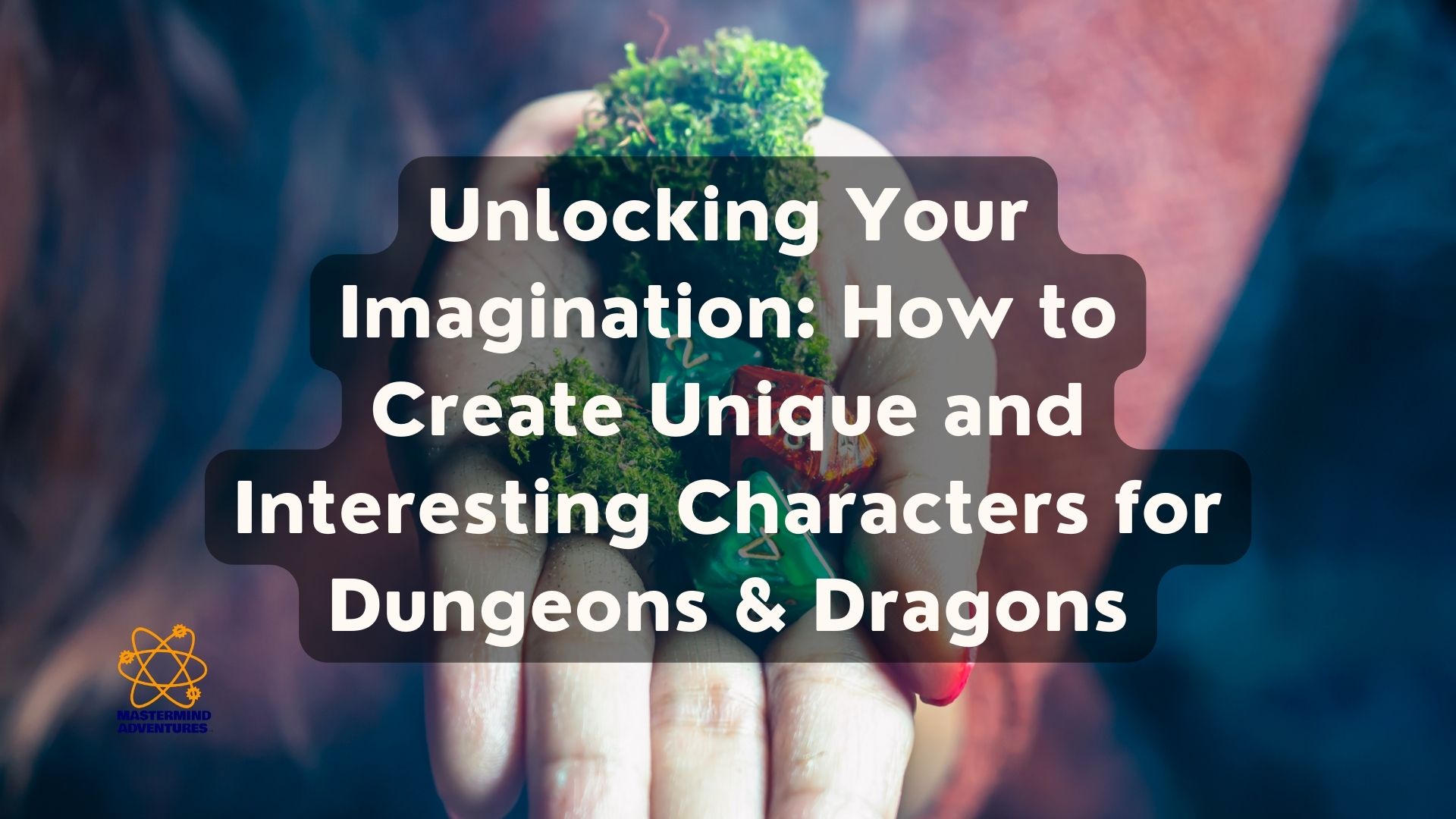
Leave A Comment